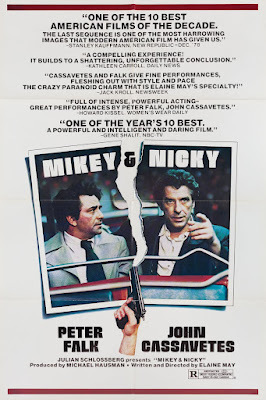Boys Will Be Boys: “Mikey and Nicky”

Elaine May has always had afraught relationship with Hollywood. After her early glory years as one-half ofthe Nichols and May comedy duo, she wrote and directed her first feature film,a pitch-black comedy called A New Leaf, in 1971. It fared poorly at thebox office, but is now considered a cult classic, inducted in 2019 into theNational Film Registry of the Library ofCongress. The following year, May directed a Neil Simon script that became amajor hit: The Heartbreak Kid, starring Charles Grodin as a jerk who dumpshis annoying bride (May’s daughter Jeannie Berlin) during their honeymoon andjumps into bed with a beautiful blonde (Cybill Shepherd). Frankly I’ve oftenfound this film disturbing in its reliance on ethnic stereotypes, but audiencesresponded with glee, and Berlin won several major awards for her outrageouslyunattractive portrayal.
So May was riding high thefollowing year when she wrote and shot Mikey and Nicky (1976), aso-called “neo-noir” starring good friends Peter Falk and John Cassavetes. WhenI watched this film, I knew nothing about where it was going. Frankly, Ithought it would play up the comic aspects of a longtime relationship. And soit did, if you like your humor very dark indeed. The film, set amid the squalorof an east-coast city, starts with Cassavetes’ Nicky holed up in a seedy hotelroom, frantically summoning his lifelong pal Mikey to save him from the wrathof a boss who’s clearly a dangerous thug. (He’s played by the legendary actingcoach Sanford Meisner.) There are some laughs to be had in Mikey (Falk) showingup with a cache of Gelusil for his buddy’s ulcer and then trying to hustle himout of town.
Thus begins an odyssey inwhich the half-crazed Nicky keeps getting distracted from his own escape plans,with Mikey keeping him company every step of the way. The full story of theirrelationship unfolds particularly in a midnight over-the-wall jaunt into alocal cemetery. There we come to fully understand how long these two have beena part of one another’s lives, sharing tender memories of family members nowlong gone. They also almost share the favors of a (sort of) prostitute: it’sher angry rejection of Mikey that becomes one of the film’s key turning points.
h both men are husbandsand fathers of young children, they are not what I’d call mature adults. Intheir slightly different ways they treat women badly: Nicky has destroyed hismarriage (to one of my longtime favorites, Joyce Van Patten) with his overtphilandering; Mikey treats his wife better but clearly doesn’t regard her as anequal. Certainly he doesn’t share with her his many secrets, including the factthat his younger brother died in childhood The film suggests that the centralrelationship in Mikey and Nicky’s lives is with one another, with all thatimplies about nostalgia, affection, and jealousy. Which makes the film’s ending truly poignant.
From what I’ve read, ElaineMay did herself no favors on the set of Mikey and Nicky. Determined tocapture the improvisational style of her two leads, she spent far more time andmoney on the film than her studio had allotted. (I’ve learned she shot almostthree times as much footage as was required for Gone With the Wind.) That’s why the final cut was taken away fromher, and the version rushed into theatres by Paramount was haphazard at best.It was 1986 before a May-approved version finally emerged. And she didn’tdirect again for eleven years. Yes, it was the notorious Ishtar.
Beverly in Movieland
- Beverly Gray's profile
- 10 followers



